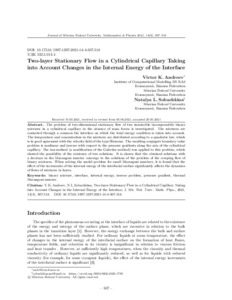Two-layer Stationary Flow in a Cylindrical Capillary Taking into Account Changes in the Internal Energy of the Interface
Скачать файл:
URI (для ссылок/цитирований):
https://elib.sfu-kras.ru/handle/2311/141720Автор:
Andreev, Victor K.
Sobachkina, Natalya L.
Андреев, Виктор К.
Собачкина, Наталья Л.
Дата:
2021Журнал:
Журнал Сибирского федерального университета.Математика и физика.Journal of Siberian Federal University. Mathematics & Physics, 2021 14 (4)Аннотация:
The problem of two-dimensional stationary flow of two immiscible incompressible binary
mixtures in a cylindrical capillary in the absence of mass forces is investigated. The mixtures are
contacted through a common the interface on which the total energy condition is taken into account.
The temperature and concentration in the mixtures are distributed according to a quadratic law, which
is in good agreement with the velocity field of the type Hiemenz. The resulting conjugate boundary value
problem is nonlinear and inverse with respect to the pressure gradients along the axis of the cylindrical
capillary. The tau-method (a modification of the Galerkin method) was applied to this problem, which
showed the possibility of the existence of two solutions. It is shown that the obtained solutions with
a decrease in the Marangoni number converge to the solutions of the problem of the creeping flow of
binary mixtures. When solving the model problem for small Marangoni numbers, it is found that the
effect of the increments of the internal energy of the interfacial surface significantly affects the dynamics
of flows of mixtures in layers Изучена задача о двумерном стационарном течении двух несмешивающихся несжимаемых бинарных смесей в цилиндрическом капилляре в отсутствие массовых сил. Смеси контактируют через общую поверхность раздела, на которой учитывается полное энергетическое условие.
Температура и концентрация в смесях распределены по квадратичному закону, что хорошо согласуется с полем скоростей типа Хименца. Возникающая сопряженная краевая задача является нелинейной и обратной относительно градиентов давлений вдоль оси цилиндрического капилляра. К
этой задаче применен тау-метод (модификация метода Галеркина), который показал возможность
существования двух решений. Показано, что полученные решения с уменьшением числа Марангони сходятся к решениям задачи о ползущем течении бинарных смесей. При решении модельной
задачи при малых числах Марангони установлено, что влияние приращений внутренней энергии
межфазной поверхности существенно сказывается на динамике течения смесей в слоях

